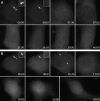The de novo centriole assembly pathway in HeLa cells: cell cycle progression and centriole assembly/maturation
- PMID: 15738265
- PMCID: PMC2171814
- DOI: 10.1083/jcb.200411126
The de novo centriole assembly pathway in HeLa cells: cell cycle progression and centriole assembly/maturation
Abstract
It has been reported that nontransformed mammalian cells become arrested during G1 in the absence of centrioles (Hinchcliffe, E., F. Miller, M. Cham, A. Khodjakov, and G. Sluder. 2001. Science. 291:1547-1550). Here, we show that removal of resident centrioles (by laser ablation or needle microsurgery) does not impede cell cycle progression in HeLa cells. HeLa cells born without centrosomes, later, assemble a variable number of centrioles de novo. Centriole assembly begins with the formation of small centrin aggregates that appear during the S phase. These, initially amorphous "precentrioles" become morphologically recognizable centrioles before mitosis. De novo-assembled centrioles mature (i.e., gain abilities to organize microtubules and replicate) in the next cell cycle. This maturation is not simply a time-dependent phenomenon, because de novo-formed centrioles do not mature if they are assembled in S phase-arrested cells. By selectively ablating only one centriole at a time, we find that the presence of a single centriole inhibits the assembly of additional centrioles, indicating that centrioles have an activity that suppresses the de novo pathway.
Figures










Similar articles
-
Kinetics and regulation of de novo centriole assembly. Implications for the mechanism of centriole duplication.Curr Biol. 2001 Mar 6;11(5):308-17. doi: 10.1016/s0960-9822(01)00094-x. Curr Biol. 2001. PMID: 11267867
-
Centrin-2 is required for centriole duplication in mammalian cells.Curr Biol. 2002 Aug 6;12(15):1287-92. doi: 10.1016/s0960-9822(02)01019-9. Curr Biol. 2002. PMID: 12176356
-
The respective contributions of the mother and daughter centrioles to centrosome activity and behavior in vertebrate cells.J Cell Biol. 2000 Apr 17;149(2):317-30. doi: 10.1083/jcb.149.2.317. J Cell Biol. 2000. PMID: 10769025 Free PMC article.
-
Centrioles: some self-assembly required.Curr Opin Cell Biol. 2008 Dec;20(6):688-93. doi: 10.1016/j.ceb.2008.09.001. Epub 2008 Oct 25. Curr Opin Cell Biol. 2008. PMID: 18840522 Free PMC article. Review.
-
Show me your license, please: deregulation of centriole duplication mechanisms that promote amplification.Cell Mol Life Sci. 2013 Mar;70(6):1021-34. doi: 10.1007/s00018-012-1102-6. Epub 2012 Aug 15. Cell Mol Life Sci. 2013. PMID: 22892665 Free PMC article. Review.
Cited by
-
What mechanisms/processes underlie radiation-induced genomic instability?Cell Mol Life Sci. 2012 Oct;69(20):3351-60. doi: 10.1007/s00018-012-1148-5. Epub 2012 Sep 6. Cell Mol Life Sci. 2012. PMID: 22955377 Free PMC article.
-
Using sea urchin gametes and zygotes to investigate centrosome duplication.Cilia. 2016 Sep 6;5(1):20. doi: 10.1186/s13630-016-0043-3. eCollection 2016. Cilia. 2016. PMID: 27602205 Free PMC article. Review.
-
RNA in centrosomes: structure and possible functions.Protoplasma. 2013 Feb;250(1):397-405. doi: 10.1007/s00709-012-0422-6. Epub 2012 Jun 10. Protoplasma. 2013. PMID: 22684578
-
Formation of extra centrosomal structures is dependent on beta-catenin.J Cell Sci. 2010 Sep 15;123(Pt 18):3125-35. doi: 10.1242/jcs.064782. Epub 2010 Aug 24. J Cell Sci. 2010. PMID: 20736306 Free PMC article.
-
The fate of extra centrosomes in newly formed tetraploid cells: should I stay, or should I go?Front Cell Dev Biol. 2023 Jul 27;11:1210983. doi: 10.3389/fcell.2023.1210983. eCollection 2023. Front Cell Dev Biol. 2023. PMID: 37576603 Free PMC article. Review.
References
-
- Brinkley, B.R. 2001. Managing the centrosome numbers game: from chaos to stability in cancer cell division. Trends Cell Biol. 11:18–21. - PubMed
-
- Brinkley, B.R., and T.M. Goepfert. 1998. Supernumerary centrosomes and cancer: Boveri's hypothesis resurrected. Cell Motil. Cytoskeleton. 41:281–288. - PubMed
-
- Hartwell, L.H., and T.A. Weinert. 1989. Checkpoints: controls that ensure the order of cell cycle events. Science. 246:629–634. - PubMed

